While using a rifle scope has great benefits, they do have their downfalls. A more complicated optic might take practice to use and can have natural scientific concepts that can affect how they work. One of those concepts is that of parallax. Parallax error is a hot topic when it comes to a riflescope. It’s also one of the biggest sources of confusion for all shooters, because a good majority of people don’t really understand it. In order to become a great shooter with a riflescope, you must first understand rifle scope parallax.

Rifle scopes are prone to this phenomenon merely because of how they operate. While it’s something that cannot truly be completely eliminated, most modern rifle scopes are equipped with a scope parallax adjustment that can compensate and correct the occurrence of parallax error.
So, don’t fret. Parallax is definitely a real problem, but it’s got real solutions too. Adjustable parallax is becoming more and more common in today’s rifle scope market. Having the option for parallax correction is a great way to ensure that you can stay accurate no matter what distance you’re shooting from.
- What is Scope Parallax?
- Types of Parallax Setting
- Steps to Correct Parallax
- Impact On Shooting Accuracy
- FAQs
- What is parallax and why is it important in shooting?
- How does parallax error occur in rifle scopes?
- What happens when a scope’s reticle shifts due to parallax?
- What is the purpose of the parallax adjustment feature?
- How can I adjust parallax on my rifle scope?
- What are the benefits of utilizing the parallax adjustment feature?
- What techniques can I use to minimize parallax in shooting?
- What are some common myths and misconceptions about parallax in shooting?
- What does the parallax setting of 100 yards mean?
- References
What is Scope Parallax?

Parallax in a telescopic sight is defined as the motion of objects that are within the same field of view where the reticle lies. What this means is that when you are looking through your optic, your target image will either appear in front of your reticle or behind your reticle. Parallax can also occur when you move your head side to side, which will cause your reticle to become out of focus or unaligned, leading to inaccuracy and an improper target image.

Let’s break this down a little bit more. In order to understand this, there’s something called a focal plane. On a riflescope, there is the first focal plane and the second focal plane. On one of these focal planes is where your reticle is going to be. Depending on that, if your target image is on the same focal plane as the reticle, there will be no parallax error present. There will also be no parallax if you are looking straight through your optic rather than at an angle.
However, when the focal planes start switching up and adding angles in there, that’s where the parallax issue will start. Also, a higher magnification scope that is made for long range shooting is more prone to parallax error than one that will be sighted for a target under 250 yards.
A riflescope that is meant to be sighted at or under 250 yards will typically not come equipped with a parallax knob, since it won’t be needed. Shooting at short ranges, the parallax issue is unnoticeable. However, with long range shooting, that is when you definitely need a parallax dial. This dial will account for and remove the parallax from your shots that are over 250 yards so you won’t lose accuracy.
What Determines if There is Parallax?
There’s two main factors that contribute to the existence of parallax in a telescopic sight.
Distance
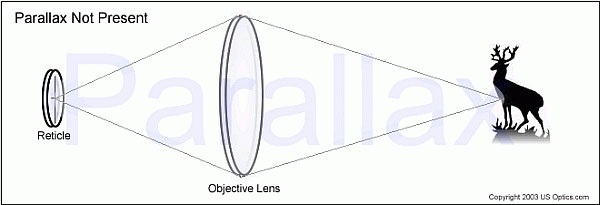
The first factor is distance. Distance from where you are shooting to where your target image stands is a huge factor in affecting whether or not parallax will be present or not. The objective lens is what creates the image that you see through your scope. The objective lens forms the image and other components inside the scope invert it, creating a parallax-free target image.
Now, where the parallax comes in is how far away the target actually is. The closer the target is, the closer it is to the objective lens, therefore the closer the image is being created. However, the further you go, and the further the image is being created away from the objective lens, is where the issue starts. Since the target image is being created further away, this pushes it out onto different focal planes than the reticle. Since the reticle is a fixed item inside the scope housing, it cannot move with the image. So, further images will present on different focal planes, therefore creating parallax.
Angle

The second factor is the angle. The angle at which you are looking through your optic also plays a big role in the presence of parallax. If your eye is perfectly lined up with the center of the scope, also known as the optical axis, then there is no parallax. When you start moving or turning your head side to side or above and below that center point is where you will find parallax.
Rifle scope parallax is present in this sense when the angle of your eye is offset from the optical axis of the scope. This will shift the reticle from its original position in your vision, therefore creating an inaccurate picture for you to shoot off of. Especially when you’re getting into the longer distances, these small errors can really start to add up.
Other Considerations
While these two factors apply to every scope, there’s also some other factors that can affect lower quality scopes. These are what you want to watch out for if you are looking into some cheap scopes. Make sure the scope is constructed in a quality manner before purchasing it.
One to watch out for is the physical construction. The reticle in a riflescope has to be placed at a precise distance from the objective lens in order to work properly. If that distance is wrong, that can be a source of parallax. Also, reticles that are not secured inside the housing and can move around, even the tiniest bit, can cause even more parallax.
The objective lens itself can also cause a parallax issue. If the curvatures and construction of the objective lens isn’t right, that’s where some parallax can come from. You’ll especially want to watch out for the adjustable objective lens on cheap scopes, because they can move around a lot and can even be poorly constructed.

Illustration of Parallax in Rifle Scopes
Types of Parallax Setting
Now, let’s talk about some parallax correction options. On modern scopes, there’s plenty of different methods that are common, including that of a parallax adjustment knob or other types of turrets.
Second Focal Plane Adjustment

This method will be an adjustable ring that is set in front of your main eyepiece. This fixed parallax ring will typically measure in yards and will allow you to conduct parallax adjustment. it will look very similar to the power adjustment rings that are found on variable power scopes. This type of adjustment is most common on fixed riflescopes, and scope magnifications of 8x-20x.
Advantages
- It’s easy to use.
- It’s easy to reach.
- It’s affordable.
Drawbacks
- It’s not a fine tune.
- It can be harder to use on a higher magnification scope.
- You won’t be able to see the yard marks if you are looking with your left eye.
Turret Adjustment
Just like every scope will have an elevation adjustment, a windage adjustment, and a focus adjustment, this method will just add another turret for the parallax adjustment. This adjustment knob will typically look just like the other adjustments and will typically be on the left side. Again, it will most likely be measured in yards.
Advantages
- It’s easy to reach.
- It’s easy to use.
- It’s familiar to most.
Drawbacks
- You can’t see the numbers unless you move your head from the scope.
- It’s not always a fine adjustment.
- It can be more expensive.
Objective Lens Adjustment
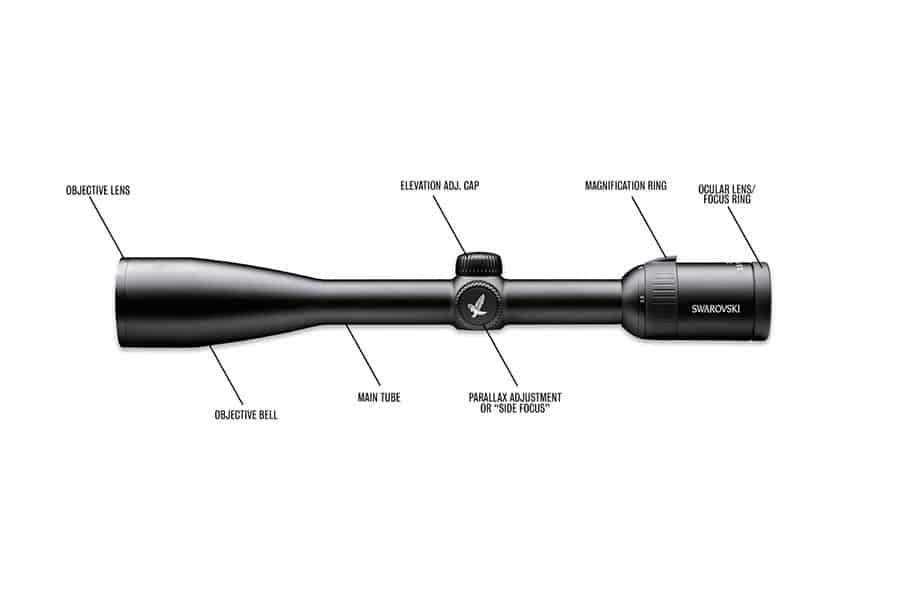
This method features a ring just like the second focal plane, but instead at the end of the scope near the objective lens. This is one of the oldest and most tested and approved methods for parallax correction. Especially if it’s made right, it can make a wide range of adjustments while also being durable as well. Typically, this ring is either adjusted with a specially tool or just manually by hand.
Advantages
- It’s efficient.
- It’s versatile.
- It’s military-grade durable.
Drawbacks
- It can be hard to reach.
- You won’t be able to see the yard marks easily.
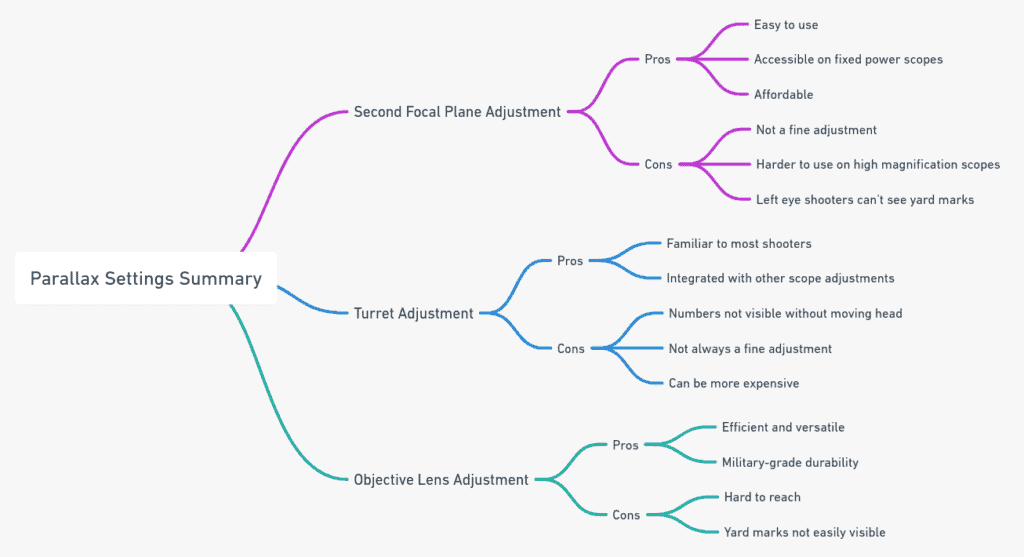
Types of Parallax Setting
Steps to Correct Parallax
While the rifle scopes might make it easier for you, there’s still some steps you should take to correct your parallax. There’s also some things you need to rule out first before going to adjust the parallax.
Make Sure Your Scope is Focused

The first thing you need to do if you suspect parallax, is test the focus of your riflescope. Having a scope that’s not in focus might give the illusion that parallax is present, so you should rule this out before you do anything else.
To test if your rifle is focused, look at an open field or yard, preferably in a brighter environment. The target doesn’t have to be far, just at least 5 yards away. Make sure you fix your focus adjustment until your target image is crisp in your vision. If your parallax is still present, then move on to the next steps.
You should always adjust your focus though before you adjust parallax. Having a focused scope will allow the parallax adjustment to work correctly and stay consistent every time you use it.
Adjusting the Parallax
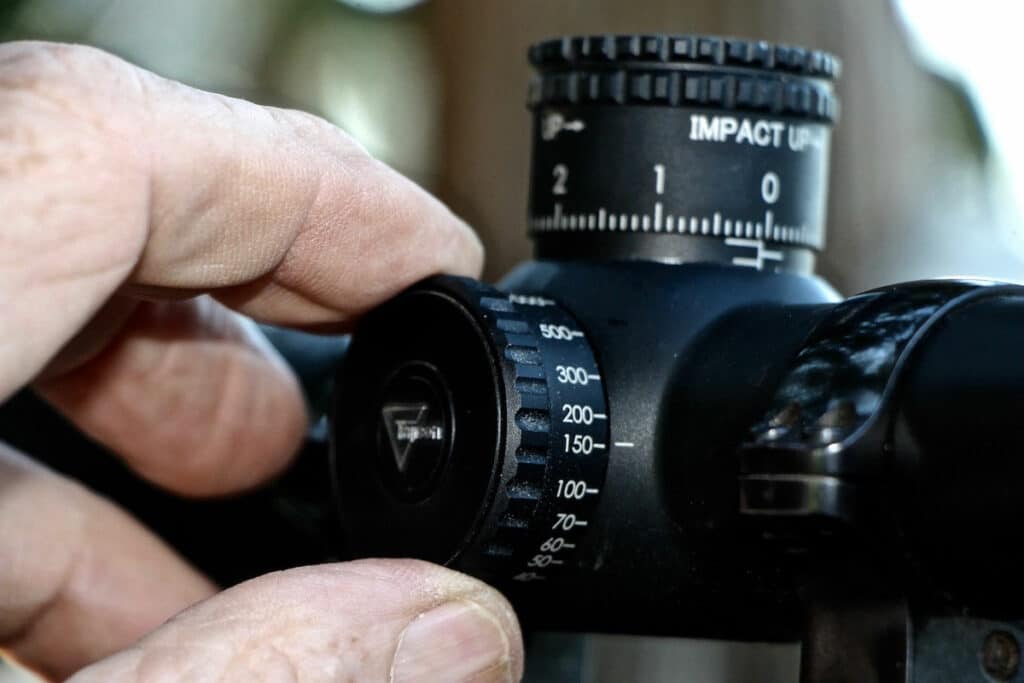
Now, it’s time to use your parallax adjustment knob and take out this problem.
- You’ll want to first put your rifle into a stand or onto a table where it will be secure and even. You’ll want to make sure that the rifle is not going to move around or wobble when you are trying to adjust it. These shakes won’t ruin your sight or your adjustments, it’s just ten times easier to adjust a stilled rifle.
- Move your parallax adjustment to the distance of your target. It’s much easier to start with a closer parallax adjustment to your target. Just take a quick estimate and adjust it from there. You might not have the exact distance of your target marked on your knob, so just pick the closest one. Just keep in mind that the knob adjustments are not always accurate.
- Aim at your target and find your correct eye position. Make sure your eye is aligned with the optical axis of your scope and that your center aiming point is on your target.
- Track the position of your reticle on the target image. Move your head a little bit and see if it moves. If the reticle moves on the target when you change your eye position, you’ve got yourself some parallax.
- Adjust your parallax knob accordingly. Test this by moving your head to the left. If your reticle is drifting to the left of your target when you move your head to the left, than you need to increase the parallax adjustment to increase the distance of the image creation. If the reticle moves to the right, than you need to decrease the parallax adjustment.
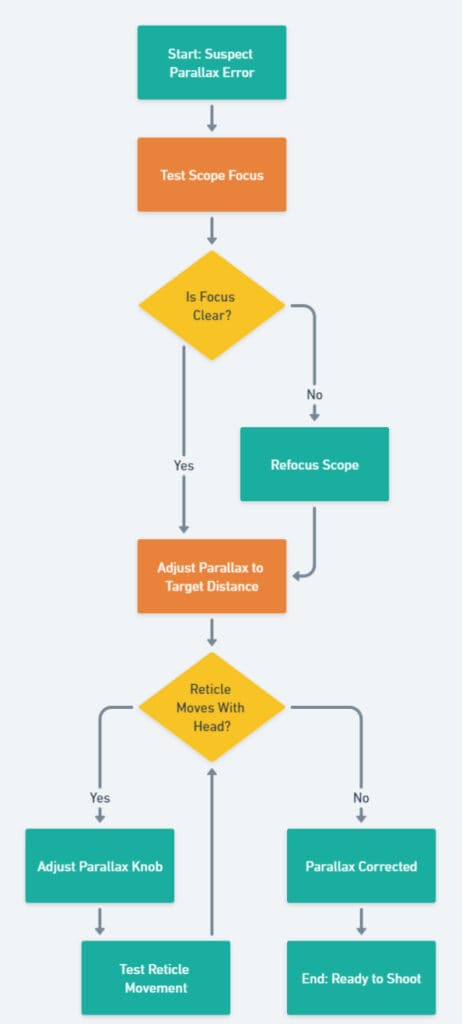
Steps to Correct Parallax
Impact On Shooting Accuracy
How Parallax Affects Accuracy
Parallax has a significant impact on shooting accuracy when using a rifle scope. Parallax occurs when the reticle and the target image appear to be on different planes due to the shooter’s eye not being perfectly aligned with the optical axis of the scope. This misalignment can lead to aiming errors and affect shot placement. When parallax is present, even a slight movement of the shooter’s head can cause the reticle to shift in relation to the target, resulting in missed shots or inconsistent groupings.
Importance of Eliminating Parallax
Eliminating parallax is really important for making your shots more accurate. Here’s why:
Better Precision
Parallax makes the crosshair and the target look like they’re not in the same place when you move your eye. By getting rid of parallax, you can make sure the crosshair stays exactly where it should be, making your aim more precise.
Consistent Shots
Parallax can cause your shots to go in different places depending on where your eye is. When you eliminate parallax, your shots will consistently hit the same spot, giving you better control and making it easier to aim consistently.
Shooting Farther
Parallax becomes a bigger problem when shooting at long distances. Even a tiny error in aiming can cause your shot to miss by a lot. Eliminating parallax helps you shoot accurately at longer ranges without worrying about the crosshair moving around.
More Confidence
When you know that parallax is gone, you can trust your scope and feel more confident in your shooting. This confidence helps you focus on your technique and perform better overall.
FAQs
What is parallax and why is it important in shooting?
Parallax refers to the displacement or apparent movement of the reticle in relation to the target image when the shooter’s eye position changes. In shooting, parallax is important because it can cause aiming errors and impact accuracy. If parallax is not properly understood and addressed, it can lead to missed shots and inconsistent results. By managing parallax, shooters ensure that the reticle and the target are aligned, improving their ability to aim accurately.
How does parallax error occur in rifle scopes?
Parallax error occurs in rifle scopes when the reticle and the target image are not on the same focal plane. This happens when the shooter’s eye is not precisely aligned with the optical axis of the scope. As a result, the reticle appears to shift relative to the target, leading to aiming errors. Parallax error is more pronounced at longer distances and higher magnifications.
What happens when a scope’s reticle shifts due to parallax?
When a scope’s reticle shifts due to parallax, it creates a misalignment between the reticle and the target. This misalignment can cause the shooter to aim inaccurately, leading to off-target shots. The reticle’s movement can give the impression that the target has moved, leading to incorrect aiming adjustments.
What is the purpose of the parallax adjustment feature?
The purpose of the parallax adjustment feature in rifle scopes is to eliminate or minimize parallax error. The adjustment feature allows shooters to align the reticle and the target image by compensating for the displacement caused by parallax. By adjusting the parallax, shooters can ensure that the reticle remains fixed in relation to the target, regardless of changes in eye position or viewing angle.
How can I adjust parallax on my rifle scope?
To adjust parallax on a rifle scope, locate the parallax adjustment feature usually located on the side of the scope. Look for markings such as distance values or symbols. Begin by setting the parallax adjustment to the distance that matches the target’s estimated range. Look through the scope and move your head slightly side to side while observing the reticle. If the reticle appears to shift in relation to the target, adjust the parallax dial until the reticle and target align. Continue fine-tuning until the reticle remains stationary when moving your head.
What are the benefits of utilizing the parallax adjustment feature?
Firstly, it eliminates or reduces parallax error, allowing for more precise aiming. Secondly, it provides a clearer and sharper target image by removing the apparent movement caused by parallax. Lastly, adjusting parallax improves shooting consistency, as it reduces the impact of eye position changes, head movement, or variations in shooting angles, resulting in more accurate and reliable shots.
What techniques can I use to minimize parallax in shooting?
To minimize parallax in shooting, ensure proper eye relief by maintaining a consistent distance between your eye and the scope. Achieve a consistent head position by anchoring your cheek firmly on the stock or cheek rest. Focus on aligning your eye with the optical axis of the scope to reduce parallax. Use a parallax adjustment feature if available on your scope. Adjust it to match the estimated target distance.
What are some common myths and misconceptions about parallax in shooting?
There are a few common myths and misconceptions about parallax in shooting:
Myth 1: Parallax is only relevant at long distances. Reality: Parallax is present at all distances but becomes more noticeable at longer ranges.
Myth 2: Parallax affects only high-magnification scopes. Reality: Parallax can impact scopes of any magnification, although its effects may be more pronounced at higher magnifications.
Myth 3: Adjusting parallax guarantees perfect accuracy. Reality: While adjusting parallax reduces aiming errors, other factors such as wind, shooter technique, and ammunition quality still play a role in overall shooting accuracy.
Myth 4: Parallax adjustment is a one-time setting. Reality: Parallax may vary based on target distance, so adjusting it for different ranges is necessary to maintain accuracy.
Understanding these misconceptions helps shooters make informed decisions and effectively address parallax for improved shooting performance.
What does the parallax setting of 100 yards mean?
If your parallax adjustment is set to 100 yards, this means that when you are looking at a target that is 100 yards away, your reticle will not move if your head moves.
References

Mike Hardesty is a published freelance gun writer. He also possesses specialized expertise in rifle scopes With dozens of articles and reviews published in Pew Pew Tactical, Snipercountry.com, and TTAG (The Truth About Guns), Mike is considered a firearms expert. His special area of expertise is handguns.
Mike is a long-time shooter. He has been punching paper targets, taking deer and other game and shooting at competitions since about 1975. Other related pursuits include reloading and bullet casting. He currently reloads for over 10 calibers, both handgun and rifle. His reloads, particularly for 9mm, were in great demand during the height of the ammo shortage among family and friends. He donated hundreds of rounds to informal shooting sessions. He was quoted as saying “I do not sell my reloads but I sure will help my guys shoot ’em for free!”. He has a few cherished firearms that he has inherited or otherwise procured — those are his favorites.
He earned B.S. and M.S. degrees from Indiana State University in 1974-1975.
He’s a firearm experts and is the founder of mhardesty.com.
